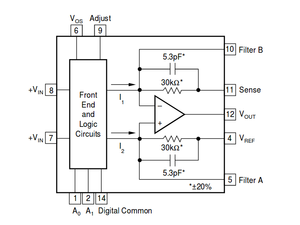Texas Instruments’ PGA20 x series
Author: OEMsecrets
One, Two, Gain!
Test equipment and sensors both profit from amplifiers which change their gain on the fly. One of Texas Instruments evergreens recently saw quite a bit of additional attention.
From a technical point of view, the part is extremely simple. As shown in the figure, the part – in essence – is an operational amplifier which subtracts the two inputs and emits the result after multiplying it with a specified gain factor. The really interesting aspect is the set of digital inputs which allow users to pick the wanted voltage level comfortably.
…PGA20 x parts are easy to use
Texas Instruments provides two different part families, which differ by the gain levels implemented. Figure two shows the available amplifier levels – simply order the one ideally suited to your application.
Texas Instruments provide two amplification classes…

While the parts power supply demands – it can work from a dual 6V supply but works best with +/-15V – are handle-able, be aware that the PGA family’s full gain bandwidth is limited to a few ten Kilohertz at best. This, clearly, is not a part intended to handle high-speed signals.
A question of performance
Being a development by Burr Brown, the PGA20 x family comes with a group of nifty tweaks not found in other opamp families. For example, output sensing is not done inside of the chip – instead, a dedicated pin lets you “slide in” amplifiers as shown in figure three.
The power booster’s gain error is eliminated via the feedback circuit…

The part can even be cascaded in a “family group”. If one PGA20 2 and one PGA20 3 are ganged up, the amount of selectable amplification levels increases greatly.
Conclusion
While the PGA20 2 / PGA20 3 family definitely is not the newest part on the market, it is a well-proven design which saw use in more than one piece of high-value test equipment. If your circuit can live with the relatively moderate speed and the large DIP housing, definitely to give the part a chance!





